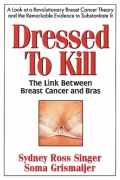
By Sydney Ross Singer and Soma Grismaijer, Directors, Institute for the Study of Culturogenic Disease
If you suffer from breast pain, cysts, or lumps, and fear developing breast cancer, you can participate in an international Breast Cancer Prevention Project.
This project has shown a 95 percent success rate in improving breast health. After years of suffering from breast pain and cysts, many participants have found phenomenal improvement within days of starting this program. It is cost-free, risk-free, and is the best thing you can do to prevent breast cancer, as well.
It all has to do with the cultural practice of wearing tight bras, and the effect this has on the circulation within the breasts. Why would bras be linked to breast disease and cancer? It has to do with the effect of bras on breast circulation, specifically the effect of bras on the lymphatic system.
It is the bloodstream’s job to deliver fresh, oxygenated fluid to the tissues and to remove carbon dioxide. It is the lymphatic system’s job to remove fluid, called lymph, from the tissue spaces, along with debris, viruses, cancer cells, bacteria, toxins, and other unwanted material.
The lymphatic system consists of microscopic vessels that originate in the tissue space and lead to larger, but still tiny, vessels that ultimately enter a lymph node. These nodes are bean-sized filters lined by white blood cells. Most of the breast’s lymph nodes are in the armpit. If the nodes detect a virus, cancer cell, or other foreign or hazardous substance in the tissue fluid, they begin an immune response of producing white blood cells to combat the problem.
Once through the lymph node the fluid works its way through larger lymphatic vessels back to the heart and the bloodstream. One important fact about the lymphatic system is that it is a passive drainage system. While the bloodstream delivers fluid under the pumping pressure of the heart, the lymphatic system has no pressure. Its flow is influenced by gravity, breathing, exercise and movement, and massage. And the slightest constriction or compression of the tissue can close the tiny lymphatic vessels down, inhibiting lymph flow and leading to fluid accumulation, cysts, pain, and tenderness. This fluid congestion within the tissue is called lymphedema.
Women who have fibrocystic breast disease essentially have lymphedema of the breast. Its cause, we discovered, is the impairment of lymphatic flow by pressure from the bra. Bras are elastic garments that exert constant pressure on the breast tissue. Their purpose is to push the breasts into a more fashionable shape. Yet, this pressure can cut down on flow within the lymphatic system, reducing its ability to remove fluid and toxins from the breast tissue.
The toxins that are within the breast tissue include some biochemical products of tissue edema, such as free radicals, which are known to cause cancer. In addition, there are also toxins in our air, food and water, including pesticides, herbicides, heavy metals, and other products of our petrochemically polluted world. Many of these are known to cause cancer. We deliver these toxins to all our tissues each day through the bloodstream. It is the job of the lymphatics to remove these toxins. And it is this job that the bra inhibits by its compression and constriction of the breasts.
This is how bras cause breast cancer. Cancer causing toxins are delivered to the breast tissue by the bloodstream, and are kept there by the bra. The toxins are the bullets. The bra holds them in place, pointed directly at the breasts.
This explains why women have more cancer in the breast than elsewhere in their bodies. The breasts are the most clothing constricted of any organ. It also explains why women have more breast cancer than men, and why breast cancer is only a problem in cultures in which bras are worn. Where there are no bras, there is virtually no breast cancer.
We had written about this, and the results of our 1991-93 Bra and Breast Cancer Study, in our book Dressed To Kill: The Link Between Breast Cancer and Bras (ISCD Press). Our study was conducted on approximately 4700 U.S. women, about half of whom had breast cancer. When the results were analyzed, they revealed that women who wear bras over 12 hours daily have a dramatically increased risk of developing breast cancer compared to bra-free women. In fact, bra-free women have about the same chances of developing breast cancer as men have, and this is over 100 times less than that for women wearing bras 18-24 hours daily. When you consider that smoking increases the incidence of lung cancer 20-30 times, this makes the link between breast cancer and bras 4-5 times greater than the link between cigarettes and lung cancer!
Of course, the easiest way for a woman to determine if her own bra is damaging her breasts is to go without a bra for a while and feel the difference. That is what the Breast Cancer Prevention Project is about. You simply have to commit to being bra-free for one month. Your body will tell you the results.
For the thousands of women who have tried this, the results are spectacular. Having bound their breasts since puberty, the feeling of breast freedom sometimes may seem strange at first. But within days, the breasts have their chance to drain of congestion and excess fluid. Tenderness ends. Menstrual breast pain may disappear altogether. Cysts vanish. It’s like a miracle.
Interestingly, some women have become so conditioned to wearing a bra that they feel uncomfortable without one. That is because their breasts have become reliant on the bra for support, causing the loss of function of the musculature and ligaments that normally support the breasts. In other words, bras cause the breasts to be weak and droop. There are many large breasted women of all ages who have firm, healthy, trouble-free breasts because they have never worn a bra.
The congestion of the breasts by the bra also increases breast weight, since the breasts are essentially swollen by edema. This can cause the breasts to feel painful when the bra is removed.
Fortunately, once the bra is no longer worn, the breasts can decongest and can develop their tone again. Many women reported that their breasts lifted up within months of ending the bra habit.
So here’s your challenge. Find a cotton or silk camisole or T-shirt that you feel comfortable in, get rid of your bra, and give your breasts a month without being bound. Then let us know your results.
If you need more information see our website www.SelfStudyCenter.org. You can also register for this study directly on our website.
 Sydney Ross Singer received a B.S. in biology from the University of Utah in 1979. He then
spent two years in the biochemistry Ph.D. program at Duke University,
followed by another two years at Duke in the anthropology Ph.D. program,
receiving a Master’s Degree. He then attended the University of
Texas Medical Branch (UTMB) at Galveston, Texas on a full academic scholarship,
where he spent one year in the medical humanities Ph.D. program, and received
an additional two years training in medical school.
Sydney Ross Singer received a B.S. in biology from the University of Utah in 1979. He then
spent two years in the biochemistry Ph.D. program at Duke University,
followed by another two years at Duke in the anthropology Ph.D. program,
receiving a Master’s Degree. He then attended the University of
Texas Medical Branch (UTMB) at Galveston, Texas on a full academic scholarship,
where he spent one year in the medical humanities Ph.D. program, and received
an additional two years training in medical school.
Soma Grismaijer received an associate’s degree from the College of Marin in the behavioral sciences, and a bachelor of arts from Sonoma State University in environmental studies and planning. In addition, she is an American Board of Opticianry-certified optician. She has been the President and Executive Director of the Good Shepherd Foundation since 1980, a charitable organization dedicated to the elimination of human and animal suffering.
Together, Singer and Grismaijer started the Institute for the Study of Culturogenic Disease in 1991. As medical anthropologists, they use medicine, anthropology, and biochemistry to discover the lifestyle causes of disease, solving medical mysteries that have baffled, and enriched, medicine.
